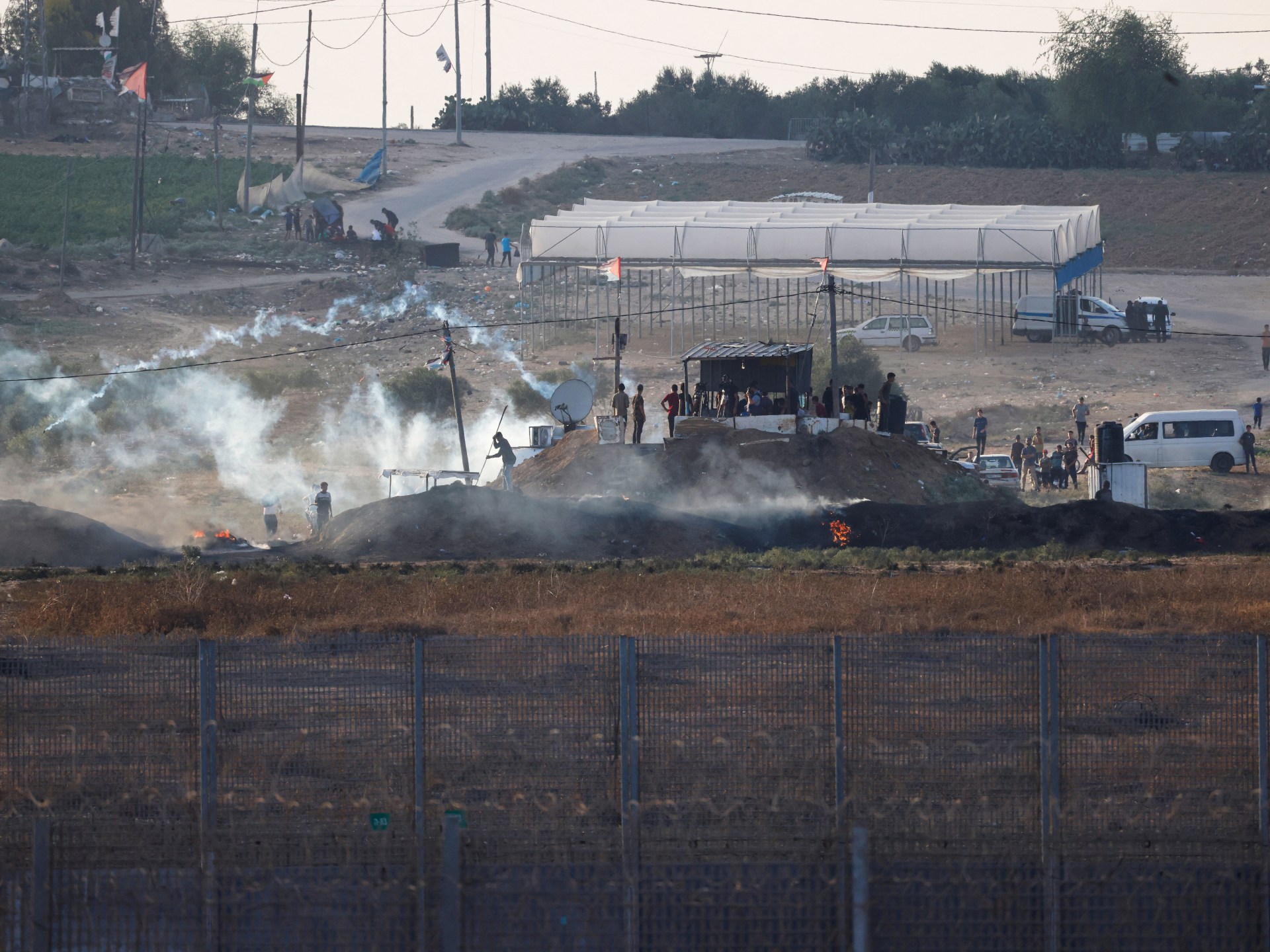‘The atmosphere was electric’ – the fall and rise of Morocco’s cinemas | Cinema
“You used to be able to smoke inside,” Omar Edressi recalls about Cinema Rif, the 86-year-old movie theatre that still stands on Tangier’s Grand Socco. “The first thing that welcomed you when you entered the building was a thick cloud of vapour.”
Tickets to the cinema were a lot cheaper in the 1970s when Edressi, a local cinema lover, would visit – it cost just one dirham ($0.10) for entrance, a sandwich and a soda. Today, a ticket will set you back by roughly 50 dirham ($5) and a soda about 15 ($1.50).
“Of course, back then we had to set up our own chairs and the place was pretty shabby, but we would still spend whole afternoons as happy as could be,” he laughs.
An art-deco building, Cinema Rif stands out from a crowd of whitewashed restaurants and shuttered buildings on Grand Socco, a quaint, palm-ringed square marking the entrance of the city’s ancient medina.
Emblazoned with bold red paint and colourful film posters, the establishment was recently restored; plush red chairs and a glaring white screen can now be found inside the glittering theatre.
The latest instalments are part of Cinema Rif’s rise-fall-and-rise-again story. Originally opened in 1938, the establishment has changed significantly from what it was during Edressi’s teenage years in the 1970s.
A ‘safe space’ to escape conservative society – for a moment
The period Edressi describes is often seen as the heyday of Moroccan cinema; by the 1980s, some 240 movie theatres across the country were regularly packed with film lovers. More than 42 million cinema tickets were purchased each year – a considerable amount considering that the population of Morocco was about 19.5 million in 1980. More tickets still were sold on the black market.
Journalist and social activist Ahmed Boughaba remembers living in Rabat during this time. In order to buy tickets for his favourite movie theatre, Cinema Renaissance, he would have to arrive an hour early and queue.
“If you were late, you would have to purchase your ticket from the black market,” Boughaba says. “The prices were always inflated and far too expensive.”

These black-market sellers would hoard tickets for popular films to sell them at a premium price. They would set up shop in shady street corners and hidden alleyways in order to avoid watchful cinema staff and authorities.
Local Tangier gallery owner, Najoua Elhitmi, remembers similar levels of popularity at Tangier’s cinemas. During the 1980s, Elhitmi recalls that movie houses were a prime meeting point for teenagers and young adults.
“You could avoid prying eyes in the darkness, so it was a good place for first dates – and first kisses…” Elhitmi trails off, laughing. “It sounds trivial, but in many ways it was a safe escape from the more conservative aspects of Moroccan society.”
Lamia Bengelloun, programmer and community manager at Cine-Theatre Lutetia in Casablanca, which first opened in 1953, tells a similarly heartwarming story. “We recently had a premiere of Asmaa El Moudir’s film, The Mother of All Lies,” Bengelloun says. “Asmaa visited the cinema to attend the screening and she told the audience that her parents’ first date was in the Lutetia.”
Cinemas were also places where people could learn about different countries and cultures. “We would come to watch Indian and Hollywood films in particular,” Elhitmi says.

Boughaba recalls travelling from Rabat to Casablanca to attend the premieres of new films.
“It would take about an hour and a half to drive there, but the atmosphere was electric,” Boughaba tells me. “That is the best thing about visiting the cinema. You can feel the energy and emotion of those around you as you watch the film – it is a shared experience.”
One of the establishments that regularly held premieres during this period was Cine-Theatre Lutetia that, along with the older art-deco Cinema Rialto – which opened in 1929 and still operates today – were also among the most popular spots in the city.
“My father and aunts tell me stories of how people used to get dressed up just to come and watch a film,” Bengelloun says, her eyes lighting up. “A trip to the cinema was an occasion that people looked forward to.”

Fall and decline: Satellite TV, pirate DVDs and streaming services
Towards the end of the 1980s and into the 1990s, Morocco’s cinemas started to close down. In Tangier, iconic establishments such as Cinema Roxy, Cinema Paris and Cinema Mauritania were all shut during this period. Cinema Liberte in Casablanca was another casualty.
By the time of the Arab Spring in 2011, Morocco’s movie theatres were very much out of fashion. This could partly be attributed to the growing availability of other forms of media, including DVDs, satellite TV and, eventually, the launch of online streaming services.
“Society started to move a lot faster. People wanted an easy fix to watch movies – not necessarily an afternoon out,” Bengelloun says. “Local favourites, like Casablanca’s Cinema Liberté, closed down as a result.”
Establishments like Cinema Liberté and Cinema Saada, also in Casablanca, were simply left abandoned. “Other spots have been destroyed or demolished,” Bengelloun says, saddened. “High-rise apartment blocks or residential buildings took their place.”
Cine-Theatre Lutetia managed to stay open, though Bengelloun explains that the property largely fell into disrepair from the early 2000s. “We weren’t making enough money to implement repairs and renovations when they were needed,” she explains.

Restoration from the ruins
In response to the decline of the country’s cinemas, the Centre Cinematographique Marocain began issuing funding to help with renovation projects. A public administrative institution headed by the Ministry of Culture, the Centre’s main aim is to promote and restore the film industry within the country.
Cine-Theatre Lutetia was one of the establishments granted money in 2019.
Today, the cinema has been returned to its original glory; art-deco details, including leather puckered doors and extensive bold lettering, are seen throughout the property. Time-worn projectors are displayed outside the screening room, which is equipped with quintessential red seating and quaint, striped drapes.
In keeping with the traditional art-deco design of the period in which many of these cinemas were built, Tangier’s Cinema Rif has been similarly restored.
Tucked behind glass cabinets, colourful posters line the facade of the establishment. Detailing the upcoming programme for the week, they are emblazoned with futuristic images from an international sci-fi thriller alongside a few somewhat fuzzier stills from locally made independent films.

Along the pavement in front of the building, crooked wooden chairs and maroon tables play host to visitors sipping from old-fashioned glass soda bottles.
The cinema’s cafe continues inside, where worn leather sofas and bar stools are crowded alongside a glass ticket office. Once again a cultural hub in Tangier, the cafe maintains a steady flow of visitors at any given time.
Edressi tells Al Jazeera that visiting the spot is extremely nostalgic for him. “So many details remain from when I used to go all those years ago, but now the space has been made available for a whole new generation.”
Slight and wide-eyed, 27-year-old Chems Eddine Nouab is the technical director at Tangier’s Cinema Rif. Nouab is responsible for sound processing and operating the projectors. He also occasionally helps to select the weekly programme and is currently writing his first film script in his spare time.

“By the time I was a teenager, most of the cinemas had closed down,” he says. “I grew up watching movies on TV and buying DVDS from local shops.
“The restoration of establishments like Rif has given me a chance to really experience the culture of the cinema.”
Rabat’s Cinema Renaissance closed down in 2006, remaining shut for several years before beginning small-scale operations again in 2013. After a series of significant renovations, the spot fully reopened its doors in 2017 as a multipurpose cultural venue.
“Before the renovations, the screening room was cramped with over 700 seats,” Marwane Fachane, executive director of Cinema Renaissance, explains. “The wooden floors were cracked and apparently there were resident rats too!”
Tasteful refurbishments were implemented throughout the property, with monochromatic tiles and gold lettering paying homage to the city’s art deco heritage. Now 350 seats are available for guests, the reduced number accommodating more legroom and modern safety measures.

Repurposed and reimagined – with community in mind
Revival efforts, though, have had to take into account modern tastes. “We also had to adapt to make the spaces relevant to modern society,” Fachane says.
One thing that Cine-Theatre Lutetia, Cinémathèque de Tanger and Cinema Renaissance have in common is that they are now called “multipurpose cultural centres”. As well as screenings, the theatres host panel discussions, musical events and film festivals.
“It is important for cinemas to differentiate themselves from streaming services and TV,” Fachane explains. “Cinemas have the added advantage of community.”
“A friend of mine lives in Meknes. There is not a cinema there, so he brings his daughters by train for our children’s mornings on Sundays. They get pancakes after and then go back home,” Fachane laughs. “The train journey is two hours long.”
It seems the concept of seeing a film as an afternoon excursion and a chance to socialise is also making a comeback.

Cinema Renaissance prides itself on being a place to discuss and exchange ideas. Its international film festivals have become particularly well known over the past few years.
During the organisation’s Italian Film Festival in September 2022, the cinema screened a range of independently made movies from the country.
“Afterwards, the attendees would discuss the themes in the films,” Fachane tells me. “It was a great way of exchanging ideas and creating a bond between different communities.”
Morocco’s revamped cinemas are focussed on uplifting the local film industry, too; Cinema Rif recently held screenings of Sound of Berberia, an independent film about two young musicians who travel across North Africa on a quest to discover regional Amazigh music.
At Casablanca’s Cine-Theatre Lutetia, an extensive programme of Moroccan films has been curated, including screenings of Animalia by Sofia Alaoui (2023), The Mother of All Lies by Asmaa El Moudir (2023), Deserts by Faouzi Bensaidi (2023) and The Damned Don’t Cry by Fyzal Boulifa (2022).
“All of these changes have helped us re-centre the cinemas’ cultural scene,” Fachane says animatedly. “They are not just revived for the older generation, but suited to the tastes of the newer ones, too.”
Check out our Latest News and Follow us at Facebook
Original Source







